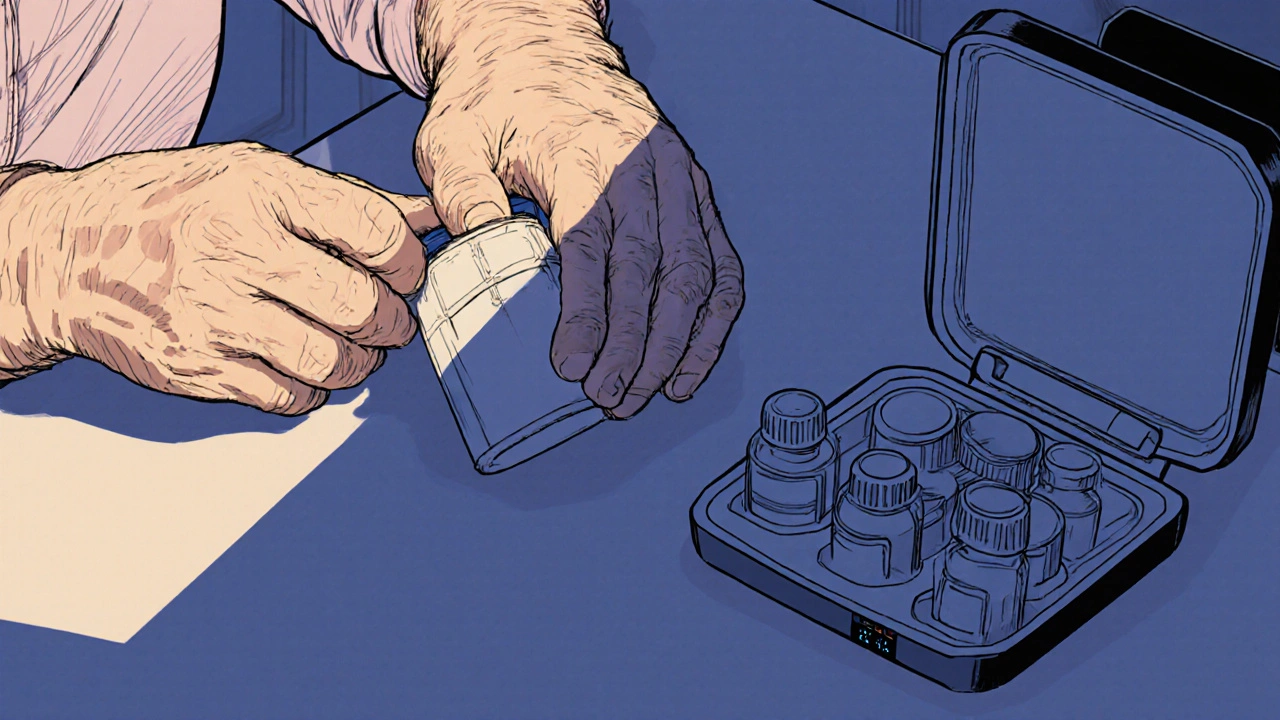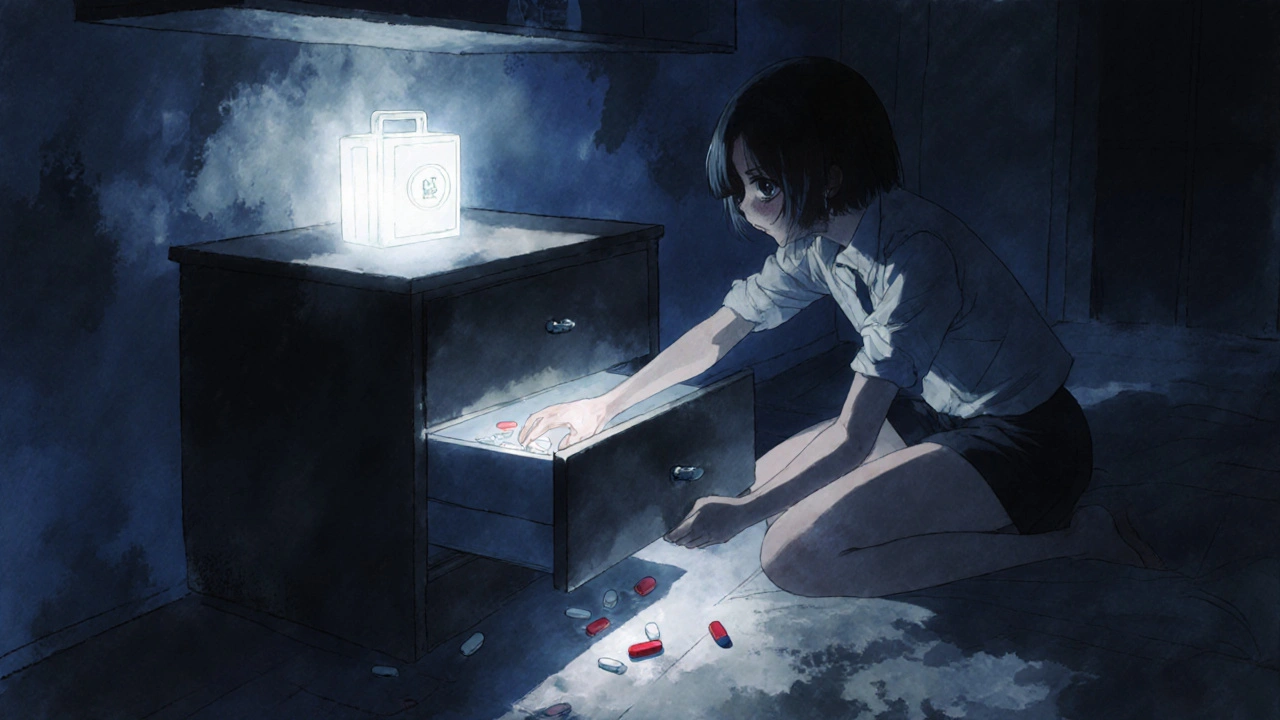Why Storing High-Risk Medications Properly Saves Lives
Every year, over 90,000 people in the U.S. die from drug overdoses. About 16,000 of those deaths involve prescription opioids - drugs like oxycodone, hydrocodone, and fentanyl that were meant to help people manage pain. But here’s the hard truth: most of these deaths don’t happen to the person who was prescribed the medication. They happen to someone else - a teenager, a grandparent, a visitor - who finds the pills in an unlocked drawer, a nightstand, or a kitchen cabinet.
Storing high-risk medications securely isn’t just a suggestion. It’s a proven way to stop overdoses before they start. The CDC says 53% of people who misuse opioids get them from friends or family - not dealers. And 60,000 kids end up in emergency rooms every year because they swallowed pills they found at home. None of these tragedies are inevitable. Most can be prevented with one simple step: locking them up.
What Counts as a High-Risk Medication?
Not all prescriptions are equally dangerous. High-risk medications include:
- Opioid painkillers - oxycodone (OxyContin), hydrocodone (Vicodin), fentanyl patches, morphine
- Benzodiazepines - alprazolam (Xanax), diazepam (Valium), clonazepam (Klonopin)
- Sleep aids - zolpidem (Ambien), eszopiclone (Lunesta)
- Stimulants - Adderall, Ritalin (when misused)
These drugs are powerful. Even a single pill can be deadly if someone isn’t used to them - especially children or people with no tolerance. And unlike antibiotics or blood pressure meds, these can shut down breathing. That’s why they’re treated differently under federal law.
The Gold Standard: Locked Storage
The most effective way to prevent accidental access is a locked container. Not a drawer with a sticky note. Not a hidden shelf. A real lock.
According to the Journal of the American Medical Association Pediatrics, using a locked box reduces accidental pediatric ingestions by 87%. That’s not a small number - it’s life-saving.
Here’s what makes a good lockbox:
- It meets ANSI Grade 2 security standards - meaning it can resist forced entry for at least 10 minutes
- It has a child-resistant latch - not just a key, but a mechanism a child can’t easily open
- It’s placed at least 4 feet off the ground - beyond the reach of most children who can climb up to 36 inches
- It’s not hidden behind other items - if it’s easy to find, it’s easier to use correctly
Basic lockboxes cost between $15 and $50. Biometric models (fingerprint access) run $100-$150. You don’t need the fancy ones. Just get one that locks. Walmart, Target, and pharmacies like CVS and Walgreens sell them in the first-aid section.
Never Transfer Pills Out of Original Containers
It’s tempting. You’ve got a big bottle of pills. You want to organize them. You dump them into a pill organizer, a vitamin jar, or even a candy box.
Don’t.
The FDA found that 68% of adults remove medications from their original packaging. And here’s why that’s dangerous:
- Child-resistant caps only work if they’re on the original bottle
- Without labels, no one knows what the pills are - not even you, if you’re confused or sick
- Emergency responders can’t identify what was taken if someone overdoses
Always keep pills in the bottle they came in. Keep the label on. Keep the child-resistant cap screwed on tight. Even if it’s hard to open - and yes, many older adults struggle with those caps - there are solutions. Look for lockboxes with built-in pill organizers that open with a code, like the Med-ic Safe Locking Pill Organizer. They let you access your meds without compromising safety.
Where Not to Store Medications
Some places are just too risky. Avoid these spots:
- Nightstands - easy access, especially at night when someone’s groggy
- Kitchen cabinets - kids climb on chairs, and guests rummage
- Bathroom cabinets - humidity ruins pills, and kids love to explore
- Purse or backpack - visitors, cleaners, or teens can grab them
- Under the mattress - it’s not hidden, it’s just lazy
The CDC found that 56% of households store high-risk meds in places kids can reach. That’s not care - that’s a gamble. Choose one spot. Lock it. And keep it locked.

Tracking and Accountability
Keeping track of how many pills are left isn’t about being suspicious. It’s about knowing when something’s missing.
Some states, like Connecticut, recommend writing down the count each day - “42 tablets remaining at 8:00 AM.” It takes two minutes. You can use a sticky note, a phone note, or a printed log.
For families with multiple caregivers, this helps avoid double-dosing. For anyone worried a loved one might be taking more than prescribed, it gives you facts - not guesses.
There are smart devices like Hero Health or MedMinder that log when a pill is taken and send alerts if someone misses a dose. But they’re expensive ($99-$149) and require tech skills. For most people, a notebook and a pen are enough.
What If You Can’t Open Child-Resistant Caps?
Many older adults, especially those with arthritis, can’t twist off child-resistant caps. Some lockboxes are just as hard to open. This isn’t a flaw in the system - it’s a design gap.
Here’s what you can do:
- Ask your pharmacist for a non-child-resistant cap - they’re allowed to provide them if you have a documented disability
- Use a lockbox with a 4-digit code - you can set it to something easy like your birth year
- Keep a key or code with a trusted neighbor or family member in case of emergency
- Use a medication dispenser that opens with a button, not a twist
You don’t have to choose between safety and access. There are tools that let you do both.
What About Disposal?
Don’t flush pills. Don’t throw them in the trash. Don’t keep expired meds for “just in case.”
Take them to a Drug Enforcement Administration (DEA) authorized collection site. These are often at local pharmacies or police stations. The DEA runs National Prescription Drug Take Back Days twice a year - in April and October - and collects nearly a million pounds of medication each time.
If you can’t get to a drop-off, mix pills with coffee grounds or cat litter in a sealed container before tossing them. This makes them unappealing and unusable. But this is a last resort. Take-back programs are safer for the environment and prevent misuse.
Why Most People Don’t Do It - And How to Change That
Only 23% of U.S. households with children use locked storage. Why? Because no one told them. A 2021 study found that only 37% of doctors discuss secure storage when prescribing opioids.
It’s not laziness. It’s ignorance. Many people think, “My kid wouldn’t do that.” But kids are curious. Teens experiment. Visitors don’t know the rules.
Change starts with one person. If you’re prescribed a high-risk medication, lock it up. Tell your family why. If you’re caring for someone who takes these meds, help them set up a system. Don’t wait for someone to get hurt.

Real Stories, Real Consequences
One Reddit user, u/PainPatient2021, wrote: “My doctor never told me to lock up my oxycodone. My 16-year-old found them in my nightstand and overdosed - thank God Narcan worked.”
Another, u/SecureMom, said: “The Walgreens lockbox saved my toddler from accessing grandma’s fentanyl patches - she pulled three drawers down trying to get it.”
These aren’t rare cases. They’re common. And they’re preventable.
What You Can Do Today
Here’s your 10-minute action plan:
- Find every high-risk medication in your home - check medicine cabinets, drawers, purses, nightstands.
- Put them back in their original bottles with child-resistant caps on.
- Buy a lockbox (under $30 at any pharmacy or online).
- Place it on a high shelf, out of reach of kids.
- Set a daily reminder to check the count - even if it’s just a note on your fridge.
You don’t need a fancy system. You don’t need to be perfect. You just need to start.
What If Someone Already Overdosed?
If you suspect an overdose - slow or stopped breathing, blue lips, unresponsiveness - call 911 immediately. Give naloxone (Narcan) if you have it. It’s available without a prescription in most states.
Then, call the Poison Help hotline at 1-800-222-1222. They’re staffed 24/7 by toxicology experts and can guide you through what to do next. In 2022, they handled over 2 million calls - and 92% of those cases were managed without a hospital visit.
Final Thought: This Isn’t About Control. It’s About Care.
Storing high-risk medications securely isn’t about distrust. It’s about protecting the people you love - including yourself. A locked box doesn’t mean you’re a bad parent, a bad patient, or a bad person. It means you’re someone who understands that medicine can heal… or kill - depending on who has access.
Every pill you lock away is one less chance for tragedy. That’s not just responsibility. That’s love in action.


Sarbjit Singh
November 18, 2025 AT 16:09Angela J
November 19, 2025 AT 17:54Sameer Tawde
November 21, 2025 AT 11:16Jeff Hakojarvi
November 22, 2025 AT 09:25Timothy Uchechukwu
November 23, 2025 AT 00:22Ancel Fortuin
November 23, 2025 AT 10:58Hannah Blower
November 23, 2025 AT 19:48Gregory Gonzalez
November 25, 2025 AT 16:52Ronald Stenger
November 27, 2025 AT 15:37Samkelo Bodwana
November 28, 2025 AT 21:24Emily Entwistle
November 28, 2025 AT 22:59Duncan Prowel
November 29, 2025 AT 19:42Bruce Bain
November 30, 2025 AT 15:02Jonathan Gabriel
December 1, 2025 AT 09:38